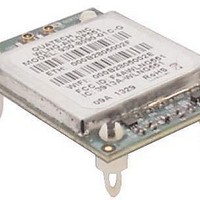WLNG-SE-DP551 Quatech, WLNG-SE-DP551 Datasheet - Page 35

WLNG-SE-DP551
Manufacturer Part Number
WLNG-SE-DP551
Description
WiFi / 802.11 Modules & Development Tools WIRELESS DEV SERVER RS-422/485 SUPPORT
Manufacturer
Quatech
Series
Airborne™r
Specifications of WLNG-SE-DP551
Wireless Frequency
2.48 GHz
Interface Type
UART
Modulation
DBPSK, DQPSK, CCK, BPSK, QPSK, 16QAM, 64QAM
Security
64/128 bit WEP, WPA, AES, EAP
Antenna
U.FL
Operating Temperature Range
- 40 C to + 85 C
Mfg Application Notes
Transition to DP550 Devices AppNote
Frequency
2.4GHz ~ 2.4835GHz
Data Rate - Maximum
54Mbps
Modulation Or Protocol
802.11 b/g
Applications
WLAN
Power - Output
-
Sensitivity
-98dBm
Voltage - Supply
3.3VDC
Current - Receiving
310mA
Current - Transmitting
240mA
Data Interface
Connector, 36 Pin Header
Memory Size
-
Antenna Connector
U.FL x 2
Operating Temperature
-40°C ~ 85°C
Package / Case
Module
Lead Free Status / Rohs Status
Details
For Use With/related Products
ARM 9, AR6002
100-8090-100
12.2 FCC RF Exposure Statement
12.3 Information for Canadian Users (IC Notice)
Changes or modifications not expressly approved by the party responsible for
compliance could void the user’s authority to operate the equipment.
To comply with FCC/IC RF exposure compliance requirements, the antenna
used for this transmitter must be installed to provide a separation distance of at
least 20 cm from all persons and must not be co-located or operate in
conjunction with any other antenna or transmitter.
As such, the radio component of this device is intended only for OEM integrators
under the following two conditions:
As long as the two conditions above are met, further transmitter testing will not
be required. However, the OEM integrator is still responsible for testing their end
product for any additional compliance requirements required with this module
installed (e.g., digital device emissions, PC peripheral requirements).
In the event that these conditions cannot be met (for example, co-location with
another transmitter), then the FCC authorization is no longer considered valid
and the FCC ID cannot be used on the final product. In these circumstances, the
OEM integrator will be responsible for re-evaluating the end product (including
the transmitter) and obtaining a separate FCC authorization.
This device has been designed to operate with an antenna having a maximum
gain of 5dBi for 802.11b/g band. An antenna having a higher gain is strictly
prohibited per regulations of Industry Canada. The required antenna impedance
is 50Ω. Only approved antenna may be used with this equipment.
Quatech maintains a full list of approved antenna, please contact your Quatech
representative for the up to date list.
To reduce potential radio interference to other users, the antenna type and its
gain should be so chosen that the Equivalent Isotropically Radiated Power
(EIRP) is not more than required for successful communication.
The installer of this radio equipment must ensure that the antenna is located or
pointed such that it does not emit RF field in excess of Health Canada limits for
the general population; consult Safety Code 6, obtainable from Health Canada’s
website www.hc-sc.gc.ca.
Operation is subject to the following two conditions: (1) this device may not cause
interference, and (2) this device must accept any interference, including
interference that may cause undesired operation of the device.
The antenna must be installed such that 20 cm is maintained between
the antenna and users.
The transmitter module may not be co-located with any other transmitter
or antenna.
4/14/2011
Quatech, Inc.
35




















